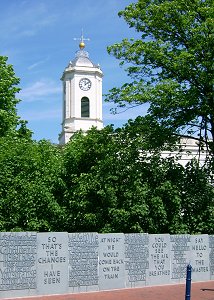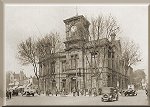The chief, if not the only,
effect that the Norman conquest had on Bilston was that one set of
landowners was replaced by another. For the inhabitants the round
of agriculture would have gone on as before.
Lawley gives the following
translations of the local entries in Domesday Book:
In Bilston there are two
hides of land, which is four caracates, and there are eight
villeins and three boarderers with three ploughs. Also one acre
of meadowland. The wood is about a furlong long and a half
broad. Was worth 20s, now 30s.
Walbertus holds of
Williams (Fitz Ansculf) one hide in Bradley. There are 2
caracates, with them are 4 villiens having one plough. The wood
is 3 furlongs long and one furlong broad. Valued and now of the
value of 67 pence. Untan holds by sac and soc. There are two
acres of meadowland.

St. Leonard's in modern times.
| The figures indicate that
Bilston was, by the standards of its time, a sizeable village and
that Bradley might be described as less developed, having more
woodland and fewer inhabitants.There is no mention in Domesday
Book of a church in either Bilston or Bradley and this
is certainly because the church at Wolverhampton was the
local parish church.
Lawley insists that
there was a church of some sort in Bilston from the earliest
Christian times and that references in old deeds to Wolverhampton
church and its chapelries show that there must have been a chapel,
at least, in Bilston. It is possible; but it is more likely that St. Leonard’s found its origins at the end of the 11th
century, when there was a spate of church building throughout the
country. It seems that after 1066
Wolverhampton and its surrounds came to be in only two manors, the
Deanery Manor and the Stow Heath Manor.
Stow Heath spread from the
centre of Wolverhampton to the east and Bilston itself was in it.
Bradley was not – it was in its own Manor of Bradley. Of Stow Heath
manor Chris Upton (in his “A History of Wolverhampton”, (1998)) says
that “Stowheath represented, in fact, a merger of the royal manors
of Bilston, Willenhall and one half of Wolverhampton, a process only
completed in the 13th century. The first lord of the
manor was Robert Burnell, Bishop of Bath and Wells and Chancellor of
England until his death in 1292. His main dwelling was … at Acton
Burnell”.
|

The Greyhound and
Punchbowl in modern times. |
The descent of the ownership
of the manors of Stow Heath and Bradley can, to a large extent, be
traced – and the details are in Lawley. Suffice it to say here that
Stow Heath Manor came into the hands of Bilston based people and
seems to have been run from the house which is now the Greyhound and
Punchbowl. Where the manor of Bradley was run from is not known.
The main function of a manor was to regulate the course of
agriculture in its area, though it exercised rather wider influence
over its inhabitants than that might suggest, not least because, in
early post-conquest times, there was not the same distinction
between criminal and civil matters as we would make today. A royal hunt in a royal forest
such as Cannock Chase or Kinver Forest.
Bradley
seems to have been a hunting ground, but not a royal
one.In addition to the manorial
courts, the area would have been run by various royal officers in
various guises, most of whom would, in due course, have been
replaced by magistrates (or Justices of the Peace) sitting in petty
sessions and quarter sessions, at both of which minor criminal
matters would have been dealt with, alongside some civil matters. There would also have been a hundred court – and Bilston was in Offlow Hundred – and a county court. These courts would have dealt
mainly with what we would see as civil matters. Doubtless
Bilstonians attended all these courts but their impact, other than
that of the manorial courts, on their daily lives would have been
small.
In medieval times we must
imagine Bilston as a village, surrounded by open fields and some
meadowland, and, beyond them, woodland areas on all sides, with the
extensive royal forests beyond them to the north and to the west.
The village’s principal roads would have been much as they are now
with the exception of Wellington Road and Oxford Street, both of
which were not to appear until the 19th century.

Return to
Before the Conquest |
|

More on After The Conquest |




